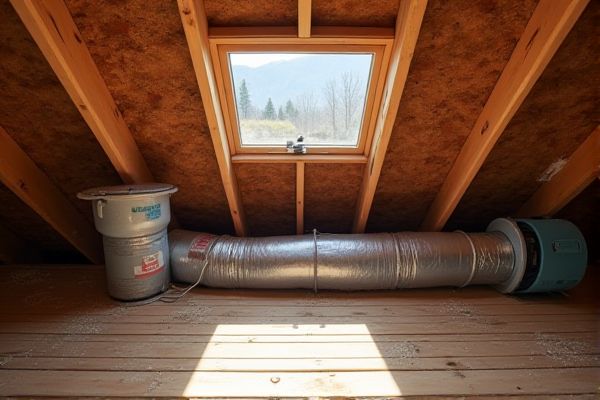
An attic HVAC vent provides consistent, energy-efficient heating by distributing warm air throughout your home, while a portable heater offers quick, localized warmth but may increase energy usage and safety risks. Discover which option best suits your heating needs and enhances your comfort by reading the rest of the article.
Table of Comparison
| Feature | Attic HVAC Vent | Portable Heater |
|---|---|---|
| Purpose | Ventilates and regulates attic temperature | Provides localized heating |
| Installation | Permanent, requires professional installation | Plug-and-play, portable |
| Energy Source | Connected to home HVAC system (electric/gas) | Electric or propane |
| Heating Efficiency | Moderate, designed for ventilation and climate control | High for small spaces, quick heat |
| Cost | Higher upfront, part of home HVAC system | Lower upfront, varies by model |
| Maintenance | Periodic HVAC system servicing | Regular filter and safety checks |
| Mobility | Fixed installation | Highly portable |
| Safety | Built-in safety with HVAC standards | Requires safety precautions (tip-over, overheating) |
| Best Use | Whole attic climate control and ventilation | Supplemental or spot heating |
Introduction to Attic HVAC Vents and Portable Heaters
Attic HVAC vents efficiently control temperature and airflow by integrating with the home's central heating and cooling system, optimizing energy use and indoor comfort. Portable heaters provide localized heating solutions, ideal for spot warming or supplemental heat without extensive installation. Understanding the differences in installation, energy consumption, and heating capacity helps homeowners choose the right option for attic or small space temperature management.
How Attic HVAC Vents Work
Attic HVAC vents function by circulating conditioned air throughout the attic space to regulate temperature and prevent moisture buildup, ensuring energy efficiency and extending the lifespan of roofing materials. These vents work by drawing in fresh air and expelling hot, stale air, maintaining proper airflow and reducing heat transfer into living areas. Unlike portable heaters, attic HVAC vents integrate seamlessly with a home's ventilation system to provide consistent climate control without the need for supplemental heating devices.
How Portable Heaters Operate
Portable heaters operate by converting electrical energy into heat through resistive heating elements or by igniting fuel such as propane or natural gas, providing localized warmth. Unlike attic HVAC vents that distribute conditioned air from a central system, portable heaters offer targeted, immediate heat, making them ideal for supplementing your heating needs in specific areas. Their compact design and ease of use allow you to quickly adjust temperature settings and move the heater to different locations as required.
Energy Efficiency Comparison
Attic HVAC vents distribute conditioned air throughout the home using a centralized system, promoting consistent energy use and reducing overall consumption by efficiently regulating temperature. Portable heaters consume significant electricity localized to small areas, often increasing energy costs when used for extended periods. Comparing energy efficiency, attic HVAC vents leverage insulation and airflow optimization, resulting in lower energy waste compared to the high wattage demands of portable heaters.
Installation and Maintenance Requirements
Attic HVAC vents require professional installation involving ductwork integration and proper insulation to ensure efficient airflow and energy use, while portable heaters offer plug-and-play convenience with minimal setup. Maintenance for attic HVAC systems includes regular filter changes, duct cleaning, and periodic inspections to prevent blockages and maintain air quality. Portable heaters need occasional cleaning and safety checks but generally demand less time and technical skill than HVAC vent systems.
Cost Considerations: Upfront and Ongoing
Attic HVAC vents generally involve higher upfront installation costs due to ductwork and system integration, but offer more energy-efficient heating, reducing ongoing utility expenses. Portable heaters present a lower initial investment with minimal setup but often result in higher operational costs because of less efficient energy use and limited heating coverage. Choosing between the two depends on balancing immediate budget constraints against long-term energy savings and comfort needs.
Heating Performance and Coverage
Attic HVAC vents provide consistent heating performance by distributing warm air evenly throughout the entire attic space, ensuring comprehensive coverage and improved energy efficiency. Portable heaters offer localized heat, which may be effective for small areas but often result in uneven temperature distribution and limited coverage. For large or poorly insulated attics, HVAC vent systems deliver superior heating performance and maintain consistent comfort levels.
Safety Factors to Consider
Attic HVAC vents provide reliable ventilation by circulating air efficiently and reducing moisture buildup, which lowers the risk of mold and structural damage. Portable heaters, while convenient, pose fire hazards if placed near flammable materials or left unattended due to their exposed heating elements. Proper installation, regular maintenance of attic HVAC vents, and adherence to manufacturer safety guidelines for portable heaters are essential to ensure safe operation in residential spaces.
Environmental Impact and Sustainability
Attic HVAC vents promote energy efficiency by distributing conditioned air uniformly, reducing the need for supplemental heating and lowering overall energy consumption. Portable heaters typically consume higher energy per unit of heat and rely on electricity or fuel sources that may have a larger carbon footprint. Choosing attic HVAC systems supports sustainable home climate control by minimizing emissions and optimizing energy use for Your long-term environmental impact.
Choosing the Right Heating Solution for Your Attic
Selecting the right heating solution for your attic involves evaluating efficiency, installation complexity, and heat distribution. Attic HVAC vents offer integrated temperature control and better air circulation by linking to your home's central system, making them ideal for long-term climate regulation. Portable heaters provide flexible, temporary warmth without permanent modification but often consume more energy and lack the consistent air distribution of a built-in HVAC system.
 homyna.com
homyna.com